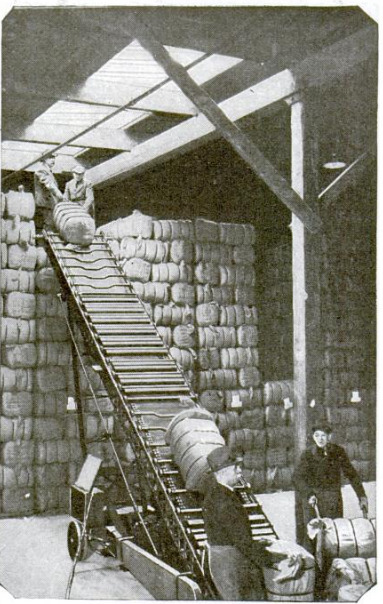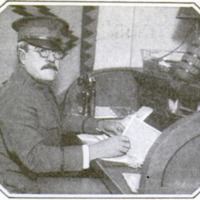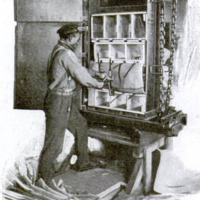How shoes and uniforms were shipped to France during World War I
Item
-
Title (Dublin Core)
-
How shoes and uniforms were shipped to France during World War I
-
Article Title and/or Image Caption (Dublin Core)
-
Save Money by Baling Your Clothes. Apply this lesson learned in the war
-
extracted text (Extract Text)
-
IF you are a manufacturer or
an exporter of clothing, it will
mean dollars and cents to you
to learn how the Quartermaster-
General's Department shipped
uniforms and shoes to France in
a way that saved the Govern-
ment eighty-five million dollars
in a little more than a year.
Few of us realize how desper-
ate was our need for ships at a
time when German submarines
were sinking six hundred thou-
sand tons a month. “Give us
ships, ships, and more ships,”
was the demand of those who
had to equip and feed our Army
in France.
In the autumn and winter of
1917-1918 it became apparent
that if the war was to last very
‘much longer there would not be
shipping space enough to carry
the equipment and supplies re-
quired by the forces that we in-
tended to send overseas. New
methods of shipping equipment
had to be invented, and the man
who invented them was Major
David T. Abercrombie, of New
York.
Compressing Twenty Cubic
Feet into Four
Clothing is usually shipped
in wooden packing-cases. But during
the war wood became scarce. Major
Abercrombie estimated that, 72,762,
800 feet of board lumber, 2,425 tons
of nails, and 404 tons of strapping
would be needed. The lumber re-
quired would have denuded 7,552
acres of timber-land—lumber that
could mot be grown again for thirty
years,
“We won't use packing-cases,” de-
cided Major Abercrombie,
“But what will you do?” they asked
him.
“Bale everything,” was the answer.
And that is how it came about that
the Government saved eighty-five
million dollars.
Major Abercrombie experimented,
and found that clothing could be
squeezed so that, roughly, twenty
cubic feet of material could be made to
oceupy four cubic feet of space. Con-
sider that ship tonnage is charged for
on a cubic foot basis, and that during
the war the rate was eight dollars per
cubic foot, and you can see at once
that by compressing twenty cubic feet
to four cubic feet a saving of ninety-six
dollars was at once effected. Then
consider that during the war
1,371,000 bales were shipped,
that the net saving on each
bale ranged from filty to
sixty dollars, and you can see
that the Government saved
eighty-five million dollars.
Major Abercrombie’s project
also released 8,180,000 cubic
feet of shipping space.
Major Abercrombie dis-
covered that proper baling
depends on the proper folding
of a uniform. Baling should
crease a uniform along the
right lines.
Folding the Garments
Scientifically
To carry out Major Aber-
crombie's process, the gar-
ment is first carefully folded
to a form. A given number
of folded garments are then packed
in a brick container, corded together
so that the bricks cannot fall apart.
The folded uniforms in their brick
container are then placed in a ma-
chine,
First of all, hand pressure is
applied to form a fairly compact
bale. But that bale is not com-
pact enough. for Major Aber-
crombie. It is subjected to the
additional squeezing effect of a
power baler until it assumes the
highly compressed form that he
has in mind.
Waterproof paper is used asa
lining for each bale. Major Aber-
crombie had to invent a paper of
his own—a creped waterproof
paper that would stretch thirty
per cent in one direction and ten
per cent in the other. Thanks to
that paper the bale becomes
absolutely waterproof.
-
Contributor (Dublin Core)
-
Michael Connors (writer)
-
Language (Dublin Core)
-
eng
-
Date Issued (Dublin Core)
-
1919-10
-
pages (Bibliographic Ontology)
-
62
-
Rights (Dublin Core)
-
Public domain (Google digitized)
-
Archived by (Dublin Core)
-
Davide Donà
-
Alberto Bordignon (Supervisor)
 Popular Science Monthly, v. 95, n. 4, 1919
Popular Science Monthly, v. 95, n. 4, 1919






